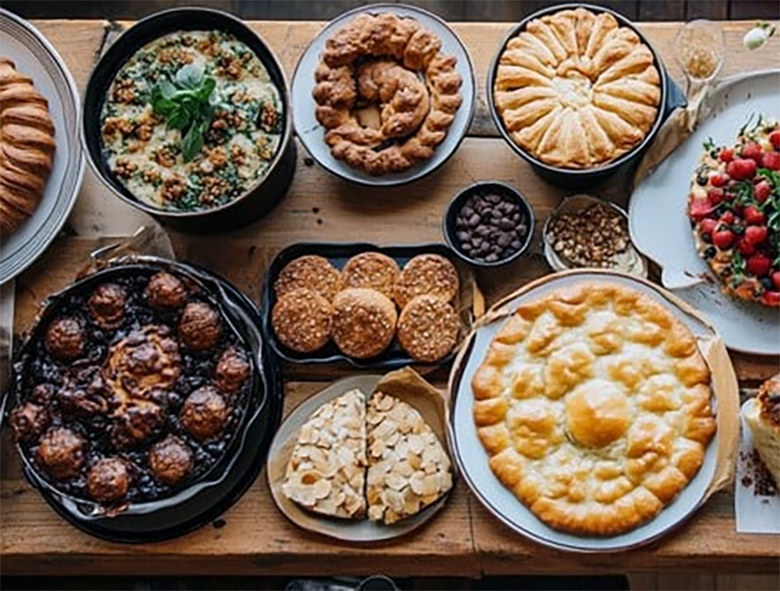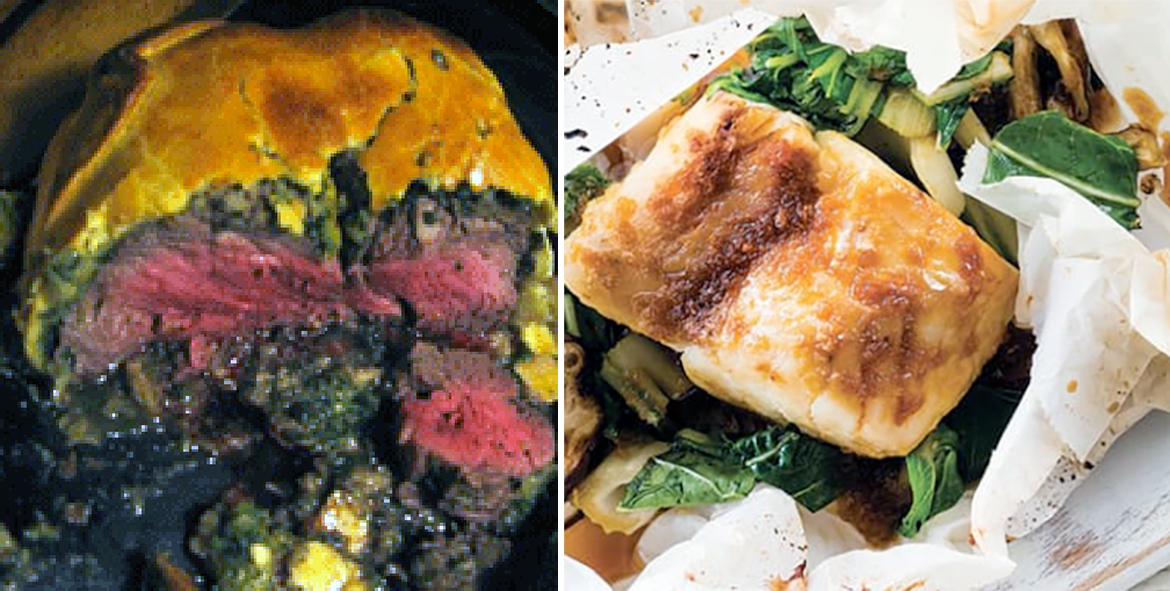FabulousFusionFood's Baking Recipes 13th Page
 A range of baked goods.
A range of baked goods.
Welcome to FabulousFusionFood's Baking Recipes Page — This is a continuation of an entire series of pages that will, I hope, allow my visitors to better navigate this site. As well as displaying recipes by name, country and region of origin I am now planning a whole series of pages where recipes can be located by meal type and main ingredient. This page gives a listing of all the baking recipes added to this site. Baking is defined as a technique for the prolonged cooking of food using dry heat by the action of conduction. Baking is normally done in an oven, but goods may also be baked in hot ashes or on hot stones. Baking differs from Roasting Recipes in that a lower temperature is typically used and the items are cooked for a longer period of time. Baking is a much older process than most people think and foods were probably originally baked in embers or with hot stones (which is how bread may have started). Only later did specialist ovens develop. Though most baked goods tend to be bread or cake-based some other dishes such as pasta dishes and vegetable dishes may also be baked. Stews are often also technically baked in an oven, but are not classed as 'baked goods' in that they are more liquid than solid at the end of the cooking process.
Baking is a method of preparing food that uses dry heat, typically in an oven, but can also be done in hot ashes, or on hot stones. The most common baked item is bread, but many other types of foods can be baked. Heat is gradually transferred "from the surface of cakes, biscuits and cookies, and pieces of bread to their centre, typically conducted at elevated temperatures surpassing 150°C. Dry heat cooking imparts a distinctive richness to foods through the processes of caramelization and surface browning. As heat travels through, it transforms batters and doughs into baked goods and more with a firm dry crust and a softer centre. Baking can be combined with grilling to produce a hybrid barbecue variant by using both methods simultaneously, or one after the other. Baking is related to barbecuing because the concept of the masonry oven is similar to that of a smoke pit.
In addition to bread, baking is used to prepare cakes, pastries, pies, tarts, quiches, biscuits and cookies, scones, crackers, pretzels, and more. These popular items are known collectively as 'baked goods', and are often sold at a bakery, which is a store that carries only baked goods, or at markets, grocery stores, farmers markets or through other venues.
 Beef en croûte (left) and fish en papillote (right).
Beef en croûte (left) and fish en papillote (right).
The alphabetical list of all the baking recipes on this site follows, (limited to 100 recipes per page). There are 2282 recipes in total:
Page 13 of 23
| Leporem farsilem (Stuffed Roast Hare with White Sauce) Origin: Roman | Mac'N'Cheese Origin: American | Mankoushe (Lebanese Pizza Dough) Origin: Lebanon |
| Les Galettes de Farine de Riz (Yeasted Rice Flour Cakes) Origin: Mali | Macadamia Nut and Toffee Tart Origin: Australia | Mansfield Gooseberry Pie Origin: England |
| Les Palmiers du Jour de Valentine (Palmiers for Valentine's Day) Origin: France | Macadamia Tart Origin: Australia | Mantecadas (Spanish Cinnamon Biscuits) Origin: Morocco |
| Leshes fryed in Lenton (Fried Cakes for Lent) Origin: England | Macaroon-topped Mince Pies Origin: British | Manx Bunloaf Origin: Manx |
| Lesser Celandine Straws Origin: Britain | Macaroons Origin: Britain | Manx Gooseberry Crumble Origin: Manx |
| Liberian Cassava Bread Origin: Liberia | Machetadas (Honduran Fried Dough) Origin: Honduras | Manx Milk Cake Origin: Manx |
| Liberian Cornbread Origin: Liberia | Mackerel Pasty Origin: England | Manx Mutton Hot-pot Origin: Manx |
| Liberian Cornbread Origin: Liberia | Macrell Ceinewydd (New Quay Mackerel) Origin: Welsh | Manx Pasties Origin: Manx |
| Liberian Pound Cake Origin: Liberia | Madeira Cake Origin: Britain | Maple Pecan Cupcakes Origin: American |
| Liberian Rice Bread II Origin: Liberia | Madeira Cake II Origin: Britain | Maple Pecan Pie Origin: American |
| Liboké de Poisson (Fish in Banana Leaf) Origin: Central Africa | Madeira Fingers Origin: England | Marble Cupcakes Origin: Britain |
| Libum (Sacral Bread) Origin: Roman | Madeira Fingers Origin: England | Marble Loaf Cake Origin: Britain |
| Libum (Diced Cheese Bread) Origin: Roman | Magic Lamb Origin: Namibia | Marchpane Origin: Britain |
| Libyan Camel Meatballs Origin: Libya | Magrood (Libyan Date Biscuits) Origin: Libya | Marie Biscuits Origin: India |
| Licky Pasty Origin: England | Maids of Honour Tarts Origin: Britain | Marie Biscuits Origin: India |
| Licky Pie Origin: England | Maisbrot aus Namibia (Namibian-style Cornbread) Origin: Namibia | Marigold Muffins (Marigold Muffins) Origin: American |
| Lilac Honey Cake Origin: Britain | Maize Flour Bread Origin: American | Marigold Tart Origin: Britain |
| Limelax (Lime Salmon) Origin: Sweden | Makaronia Pastitsio (Macaroni with Minced Meat and Bechamel Sauce) Origin: Cyprus | Marmalade Cake Origin: Scotland |
| Lincolnshire Haslet Origin: England | Make-ahead Mulled Wine Cake Origin: Britain | Marmalade muffins Origin: Scotland |
| Linden Chocolate Mississippi Mud Pie Origin: American | Makerouns (Macaroni) Origin: England | Marmorkuchen (German Marble Cake) Origin: Germany |
| Linden Leaf Flour Origin: France | Makhan Chicken Origin: India | Marraquetas (Chilean French Bread Rolls) Origin: Chile |
| Linden Leaf Flour Bread Origin: France | Makovnjaca (Poppy Seed Roll) Origin: Croatia | Marzipan Centre Bundt Cake Origin: Fusion |
| Ling Fillets with Parsley and Tomato Pesto Origin: Britain | Maltese Pastizzi Origin: Malta | Marzipan Karotten (Marzipan Carrots) Origin: Switzerland |
| Linzer Torte Origin: Germany | Malva Pudding Origin: South Africa | Mascarpone Cupcakes with Strawberry Glaze Origin: American |
| Liv Syrnyk (Easter Cheesecake with Sultanas) Origin: Ukraine | Mamoul Origin: North Africa | Massak'a (Egyptian Moussaka) Origin: Egypt |
| Llysiau Gyda Saws Caws (Vegetables in a Cheese Sauce) Origin: Welsh | Manchet Origin: Britain | Matzo Bread Origin: Israel |
| Lobster and Clotted Cream Tart Origin: Britain | Mandelbroit (Mandel Bread) Origin: Jewish | Matzo Crackers Origin: Jewish |
| Locustas Assas sic Facies (Roast Lobster is Made Thus) Origin: Roman | Mandelskorpor (Almond Rusks) Origin: Denmark | Matzo Meal Biscuits Origin: Jewish |
| Lorna Doone Shortbread Cookies Origin: American | Mandelspritzgebäck (German Almond Christmas Biscuits) Origin: Germany | Maza (Barley Cake) Origin: Roman |
| Loseyns (Lozenges) Origin: England | Mandioca Assada com Xarope de Cana (Baked Cassava with Cane Syrup) Origin: Guinea-Bissau | Mbatata Biscuits (Sweet Potato Biscuits) Origin: Malawi |
| Lumbardy Tarts Origin: Britain | Mango Pumpkin Pie with Gingersnap Crust Origin: Fusion | Mealie Cornbread Origin: South Africa |
| Luncheon Cake Origin: Britain | Mankaron (Antillean Macaron) Origin: Aruba | Meat and Potato Pasty Origin: England |
| Luscious Lime Cupcakes Origin: Britain | Mankaron (Antillean Macaron) Origin: Bonaire | |
| Maandazi (Swahili Doughnuts) Origin: Tanzania | Mankaron (Antillean Macaron) Origin: Curacao |
Page 13 of 23